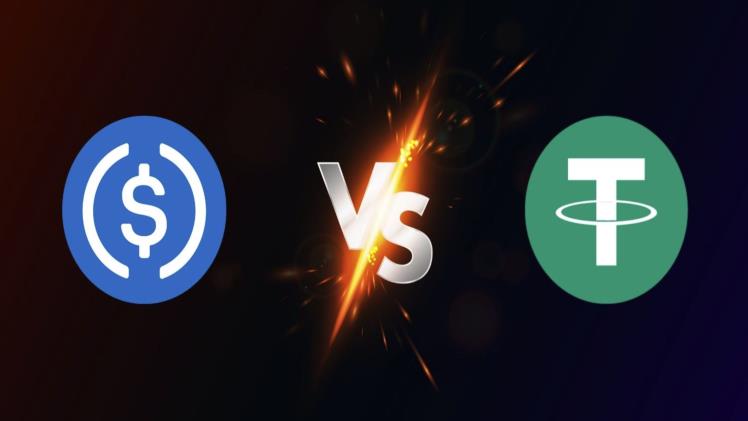USDC vs. USDT: The Ultimate Comparison

USDT and USDC currently represent the largest stablecoins. Stablecoins, a type of cryptocurrency tied to an external reference point such as the USD, is used to stabilize the currency and minimize fluctuations. Stablecoins are usually backed with assets such as cash or gold to ensure sufficient reserves are available to keep the peg in place. USDC has a circulating supply exceeding 52 billion tokens with a current value of $1.00. This results in market capital of more than $52 billion. USDT has a circulating supply of 79.5 billion tokens with a current value of $1.0006, which results in market capital of $79.38billion.
What is USDT?
Tether’s USDT, also known as Tether, is widely recognized as the first stablecoin. USDT is the symbol for Tether’s USD stablecoin (also called Tether). It’s the fourth largest market capitalization. It was first launched as a digital token backed with fiat currency in 2014. The USDT is pegged at 1:3 to the U.S. dollar to maintain stability in the exchange rate. It can be used, transferred, and traded as any other cryptocurrency once USDT has been issued. Its value is tied to the reserve fiat currency.
What is USDC?
After we have covered USDT, let’s take a closer look at USDC in crypto. Circle and Coinbase established USDC in 2018. It’s pegged at 1:3 with the U.S. dollar. Unlike USDT, where Tether is the sole issuer, USDC may be issued by other members of the CENTRE Network, such as Coinbase.
USDC commercial issuers must meet compliance, technical, and operational requirements. To ensure USDC has a consistent one-to-one backing, issuers must also back tokens with fiat reserves and provide monthly proof of reserves.
USDT vs USDC – What Are The Key Differences Between the Two?
Although USDT and USDC have many similarities, it’s essential to understand the differences before trading.
Launch date
USDT is much more popular than USDC and even other cryptocurrencies. USDT was launched in 2014. at the same time, USDC was issued in 2018. This does not necessarily mean USDC has more advanced applications to ensure optimal performance, but it does mean USDT is more widely adopted and has more financial backing.
Blockchain variation
USDT is built upon one blockchain (Ethereum), but USDC relies on multiple blockchains to accomplish its operational goals. USDC is based on the Ethereum network, as previously mentioned, and the Stellar, Solana, and Algorand blockchains. USDC could potentially benefit from multiple networks rather than one. It does, however, mean that USDC’s currency is not as localized as USDT. This can lead to confusion.
Stability of reserve assets
Both currencies are based on the same wealth structure (U.S. Dollar), but there have been issues with this system. Although USDC maintained a steady 1:1 ratio, investors and economists have expressed concern that USDT (Tether) might not have sufficient dollar reserves to support their released currency. The USDT price has been slightly inflated, which is a destabilizing factor for the company’s claim to be a stablecoin.
The volume of trade/liquidity
The stablecoin volume refers to the number of trades that occur in a given time. Refers to the number of coins available for trading at a set price (which in both cases is $1). The volume of coins traded should be higher than the difficulty in trading them. Due to its high adoption rate, USDT has a higher trade volume than other coins. USDT has a trading volume of over $54 billion, while USDC is currently at $4 billion. This should be a sign of its popularity if anything.
After examining the similarities and differences between USDT & USDC, let’s now look at the benefits and drawbacks of these two systems.
Who is Behind USDC and USDT
Another critical difference between USDT & USDC is their source. Both tokens were created and launched by different companies with different histories.
- Tether: Tether started its existence under a different name in 2014, Real coin. The company was later rebranded as Tether by Brock Pierce and Reeve Collins. USDT was the company’s original token. It was initially launched on a layer in Bitcoin Blockchain. However, it was changed back to Ethereum during the rebranding and shift. Tether Limited owns USDT and Tether.
- USD Coin: USD Coin and USDC began their lives simultaneously in 2018. Circle founded USDC to address issues that plagued emerging stablecoins, such as a lack of transparency. Although the company has made significant progress over its rivals in recent years, it is still significantly smaller than the other two. CENTRE consortium owns USD Coin and USDC.
Start Investing in Stablecoins
Diversifying your investments to include stablecoins can be a great way to profit from the cryptocurrencie market growth without taking on the volatility associated with other cryptocurrencies. Compared to the volatile gains and losses associated with cryptocurrencies such as bitcoin and KuCoin, stablecoins such as USDT and USDC always maintain their value at US$1.




